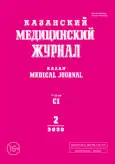Показатели системы гемостаза и уровень магния у пациентов с β-талассемией
- Авторы: Алиева Н.Р.1
-
Учреждения:
- Научно исследовательский институт гематологии и трансфузиологии, центр талассемии
- Выпуск: Том 101, № 2 (2020)
- Страницы: 188-192
- Тип: Теоретическая и клиническая медицина
- URL: https://journals.rcsi.science/kazanmedj/article/view/26273
- DOI: https://doi.org/10.17816/KMJ2020-188
- ID: 26273
Цитировать
Полный текст
Аннотация
Цель. Изучение показателей системы гемостаза и уровня магния у больных β-талассемией.
Методы. Объектом исследования служила сыворотка крови 96 женщин с β-талассемией: 46 больных промежуточной β-талассемией и 50 пациенток с малой β-талассемией, не имеющих клинических проявлений гиперкоагуляции. В качестве контроля использована сыворотка крови 30 практически здоровых женщин-доноров крови. Исследованы показатели гемостаза: количество тромбоцитов, активированное частичное тромбопластиновое время, протромбиновое время, уровень фибриногена плазмы крови, содержание D-димера, время лизиса эуглобулинового сгустка, активность антитромбина III. Определены уровень магния в сыворотке крови и риск дефицита посредством опросника MDQ (от англ. Menstrual Distress Questionnaire).
Результаты. У больных промежуточной β-талассемией выявлено повышение уровня маркёра тромбинемии D-димера (>500 нг/мл.). Больные промежуточной β-талассемией по выявленному уровню D-димера были разделены на две группы: первая — 14 (30,4%) больных с латентной гиперкоагуляцией, вторая — 32 (69,6%) больных без латентной гиперкоагуляции. Установлено, что в группе с высоким содержанием D-димера был повышен уровень фибриногена, увеличено время фибринолиза, снижено активированное частичное тромбопластиновое время и несколько уменьшена активность антитромбина III. Уровень магния в сыворотке крови первой группы больных был ниже, а риск дефицита по опроснику — выше, чем у больных второй группы. Показатели гемостаза и уровень магния у пациенток с малой β-талассемией не отличались от группы контроля.
Вывод. Треть пациенток с промежуточной β-талассемией имеют предтромботическую готовность гемостаза — латентную гиперкоагуляционную активность и дефицит магния, которые могут служить предикторами клинических признаков тромбозов.
Ключевые слова
Полный текст
Открыть статью на сайте журналаОб авторах
Наргиз Рафик гызы Алиева
Научно исследовательский институт гематологии и трансфузиологии, центр талассемии
Автор, ответственный за переписку.
Email: doktor.narqiz@mail.ru
Азербайджан, г. Баку, Азербайджан
Список литературы
- Cappellini M.D., Musallam K.M., Taher A.T. Тhalassemia as a hypercoagulable state. US Oncol. Hematol. 2011; 7: 157‒160. doi: 10.17925/OHR.2011.07.2.157.
- Cappellini M.D., Motta I., Musallam K.M., Taher A.T. Redefining thalassemia as a hypercoagulable state. Ann. NY Acad. Sci. 2010; 120: 231‒236. doi: 10.1111/j.1749-6632.2010.05548.x.
- Воробьёв А.И., Васильев С.А., Городецкий В.М. и др. Гиперкоагуляционный синдром: классификация, патогенез, диагностика, терапия. Гематол. и трансфузиол. 2016; (3): 116–122. doi: 10.18821/0234-5730-2016-61-3-116-122.
- Момот А.Р. Проблема тромбофилии в клинической практике. Рос. ж. детской гематол. и онкол. 2015; (1): 36–48. doi: 10.17650/2311-1267-2015-1-36-48.
- Копина М.Н., Гаевский Ю.Г. Гиперкоагуляционные нарушения гемостаза у больных впервые выявленной железодефицитной анемией. Вестн. Новгородского гос. ун-та. 2013; 1 (71): 21–24.
- Керимов А.А. Латентные гиперкоагуляционные нарушения гемостаза. Современные достижения азербайджанской медицины. 2014; (4): 116–122.
- Громова О.А., Калачёва А.Г., Торшин И.Ю. и др. Недостаточность магния — достоверный фактор риска коморбидных состояний: результаты крупномасштабного скрининга магниевого статуса в регионах России. Фарматека. 2013; (6): 16–28.
- Керимов А., Алиева Н., Мамедова Т., Гафарова С. Значение уровня магния в гемостазе больных бета-талассемией. Биомедицина (Баку). 2016; (1): 15–19.
- Андриадзе Н.А., Кобалава М.А. Повышение риска стимуляции тромбоцитзависимого тромбоза низким уровнем магния в плазме крови при остром инфаркте миокарда. Рос. кардиол. ж. 2004; (6): 14–17. doi: 10.15829/1560-4071-2004-6-14-17.
- Баркаган З.С., Момот А.П. Диагностика и контролируемая терапия нарушений гемостаза. M.: Нью-Диамед. 2008; 292 р.
- Серов В.Н., Блинов Д.В., Зимовина У.В., Джобава Е.М. Результаты исследования распространённости дефицита магния у беременных. Акушерство и гинекол. 2014; (6): 33–40.
- Громова O.A., Калачёва A.Г., Торшин И.Ю. О диагностике дефицита магния. Часть 1. Арх. внутренней мед. 2014; (2): 5–10. doi: 10.20514/2226-6704-2014-0-2-5-10.
- Cappelini M.D., Poggiali E., Taher S. et al. Hypercoagulolity in beta-thalassemia — a status quo. Expert. Rev. Hematol. 2012; 5: 505–512. doi: 10.1586/ehm.12.42.
Дополнительные файлы






